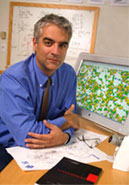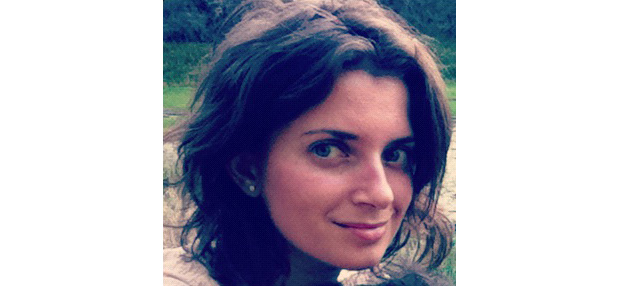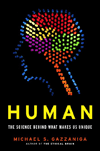It is customary to think about fashions in things like clothes or music as spreading in a social network. But it turns out that all kinds of things, many of them quite unexpected, can flow through social networks, and this process obeys certain rules we are seeking to discover. We've been investigating the spread of obesity through a network, the spread of smoking cessation through a network, the spread of happiness through a network, the spread of loneliness through a network, the spread of altruism through a network. And we have been thinking about these kinds of things while also keeping an eye on the fact that networks do not just arise from nothing or for nothing. Very interesting rules determine their structure.

Introduction
On of the oft-repeated phrases on Edge is "New Technologies=New Perceptions". As we create tools we recreate ourselves. In the digital information age, we have moved from thinking about silicon, transistors, and microprocessors, to redefining, to the edge of creating life itself. As we have seen in recent editions of Edge — "Life: What A Concept!" (Freeman Dyson, Craig Venter, George Church, Robert Shapiro, Dimitar Sasselov, Seth Lloyd) at Eastover Farm in August, "Life: A Gene-Centric View" (Richard Dawkins and Craig Venter) in Munich in January; "Engineering Biology" (Drew Endy) in our most recent edition — we are redefining who and what we are.
Such scientific explorations are not limited to biology. Recently, Harvard professor and sociologist Nicholas Christakis has shown that there's more to think about regarding social networks such as Facebook, MySpace, Flickr, and Twitter than considerations of advertising and revenue models. According to The New York Times , ("On Facebook, Scholars Link Up With Data", by Stephanie Rosenbloom 12.17.07):
Each day about 1,700 juniors at an East Coast college log on to Facebook.com to accumulate "friends," compare movie preferences, share videos and exchange cybercocktails and kisses. Unwittingly, these students have become the subjects of academic research. To study how personal tastes, habits and values affect the formation of social relationships (and how social relationships affect tastes, habits and values), a team of researchers from Harvard and the University of California, Los Angeles, are monitoring the Facebook profiles of an entire class of students at one college, which they declined to name because it could compromise the integrity of their research.
Christakis notes that he is "interested not in biological contagion, but in social contagion. One possible mechanism is that I observe you and you begin to display certain behaviors that I then copy. For example, you might start running and then I might start running. Or you might invite me to go running with you. Or you might start eating certain fatty foods and I might start copying that behavior and eat fatty foods. Or you might take me with you to restaurants where I might eat fatty foods. What spreads from person to person is a behavior, and it is the behavior that we both might exhibit that then contributes to our changes in body size. So, the spread of behaviors from person to person might cause or underlie the spread of obesity."
In a page one story in The New York Times last summer ("Find Yourself Packing It On? Blame Friends" 7.26.07), Gina Kolata noted:
Obesity can spread from person to person, much like a virus, researchers are reporting today. When one person gains weight, close friends tend to gain weight, too.
Their study, published in The New England Journal of Medicine, involved a detailed analysis of a large social network of 12,067 people who had been closely followed for 32 years, from 1971 to 2003.
The investigators knew who was friends with whom as well as who was a spouse or sibling or neighbor, and they knew how much each person weighed at various times over three decades. That let them reconstruct what happened over the years as individuals became obese. Did their friends also become obese? Did family members? Or neighbors?
The answer, the researchers report, was that people were most likely to become obese when a friend became obese. That increased a person's chances of becoming obese by 57 percent. There was no effect when a neighbor gained or lost weight, however, and family members had less influence than friends.
It did not even matter if the friend was hundreds of miles away, the influence remained. And the greatest influence of all was between close mutual friends. There, if one became obese, the other had a 171 percent increased chance of becoming obese, too. ...
Christakis, along with his colleague James Fowler, "have started with several projects that seek to understand the processes of contagion, and we have also begun a body of work looking at the processes of network formation — how structure starts and why it changes. We have made some empirical discoveries about the nature of contagion within networks. And also, in the latter case, with respect to how networks arise, we imagine that the formation of networks obeys certain fundamental biological, genetic, physiological, sociological, and technological rules. "
"So we have been investigating both what causes networks to form and how networks operate."
— JB
NICHOLAS A. CHRISTAKIS, a physician and sociologist, is a Professor at Harvard University with joint appointments in the Departments of Health Care Policy, Sociology, and Medicine. For the last ten years, he has been studying social networks.
Nicholas Christakis's Edge Bio Page
THE REALITY CLUB: Douglas Rushkoff, Alan Alda Nicholas Christakis






